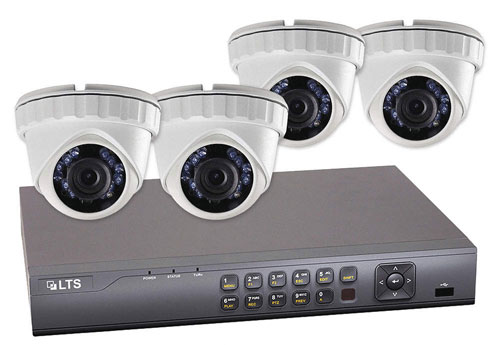

o DVR's
What is a DVR?
What is a DVR?
A digital video recorder (DVR) is an electronic device that records video in a digital format to a disk drive, USB flash drive, SD memory card, SSD or other local or networked mass storage device. Personal computers are often connected to video capture devices and used as DVRs; in such cases the application software used to record video is an integral part of the DVR.
Digital video recorders configured for physical security applications record video signals from closed-circuit television cameras for detection and documentation purposes. Manufacturers design many DVRs to have built-in audio recording capabilities. DVRs have transformed into feature-rich devices that offer advanced services beyond the basic video recording functionality provided by VCRs. A DVR CCTV system provides a multitude of advanced functions over VCR technology including video searches by event, time, date and camera.
The DVR provides extensive control over quality and frame rate, enabling optimized disk space utilization. Furthermore, users can configure the DVR to automatically replace the oldest security footage once the disk is full. Some DVR security systems allow remote access to security footage via a PC by connecting the DVR to a LAN network or the Internet. Some of the latest professional digital video recorders include video analytics firmware, to enable functionality such as ‘virtual tripwire’ or even the detection of abandoned objects on the scene.
We can categorize security DVRs into two types: PC-based and embedded. A PC-based DVR is essentially a regular personal computer equipped with video capture cards for capturing video images. On the other hand, an embedded DVR is specifically designed as a digital video recorder, with its operating system and application software stored in firmware or read-only memory
Hardware Features:
Hardware features of security DVRs vary between manufacturers and may include but are not necessarily limited to:
Designed for rack mounting or desktop configurations.
Single or multiple video inputs with connector types consistent with the analogue or digital video provided such as coaxial cable, twisted pair or optical fiber cable. The most common number of inputs are 1, 2, 4, 8, 16 and 32. Users can configure systems with a significant number of inputs by networking or connecting individual DVRs together.
Looping video outputs for each input which duplicates the corresponding input video signal and connector type. Other video equipment, such as matrix switchers, multiplexers, and video monitors, utilize these output signals.
Controlled outputs to external video display monitors.
The machine incorporates front panel switches and indicators that enable users to control its various features.
The network connections align with the network type and enable control over recorder features. They also facilitate the transmission and reception of video signals.
Connections to external control devices such as keyboards.
A connection to external pan-tilt-zoom (PTZ) drives that position cameras.
Internal CD, DVD, VCR devices typically for archiving video.
Connections to external storage media.
Alarm event inputs from external security detection devices, usually one per video input.
Alarm event outputs from internal detection features such as motion detection or loss of video.
Software Features
Software features vary between manufacturers and may include but are not necessarily limited to:
User selectable image capture rates either on an all input basis or input by input basis. Users can program the capture rate feature to automatically adjust the capture rate when an external alarm or internal event occurs.
Selectable image resolution either on an all input basis or input by input basis. The image resolution feature can automatically adjust the image resolution based on external alarms or internal events. This programming enables dynamic resolution changes for enhanced surveillance capabilities.
Compression methods determine quality of playback. H.264 hardware compression offers fast transfer rates over the Internet with high quality video.
Motion detection: Provided on an input by input basis, this feature detects motion in the total image or a user definable portion of the image and usually provides sensitivity settings. When detection occurs, it triggers an internal event that can be sent to external equipment or activate changes in other internal features.
Lack of motion detection. This feature detects object movement within the field of view on a per-input basis. It recognizes when an object remains motionless for a user-defined period of time. When detection occurs, it triggers an internal event. This event can be output to external equipment or used to initiate changes in other internal features.
Contact US
Direction of motion detection. This feature detects the user-defined unacceptable direction of motion in the image for each input. Detection then triggers an internal event that can be sent to external equipment or activate modifications in other internal features.
Routing of input video to video monitors based on user inputs or automatically on alarms or events.
Input, time and date stamping.
Alarm and event logging on appropriate video inputs.
Alarm and event search.
One or more sound recording channels.
Archival.
Network video recorders (NVRs) differ from digital video recorders (DVRs) in terms of input source. NVRs receive input from a network instead of a direct connection to a video capture card or tuner. The DVR encodes and processes video directly on the DVR itself. In contrast, the NVR encodes and processes video at the camera before streaming it to the NVR for storage or remote viewing.[citation needed] The NVR can perform additional processing tasks, including further compression or adding meta data to the recorded video.
There are hybrid NVR/DVR surveillance systems available that combine the functionalities of both NVR and DVR. Experts classify these systems as a specific type of NVR.
